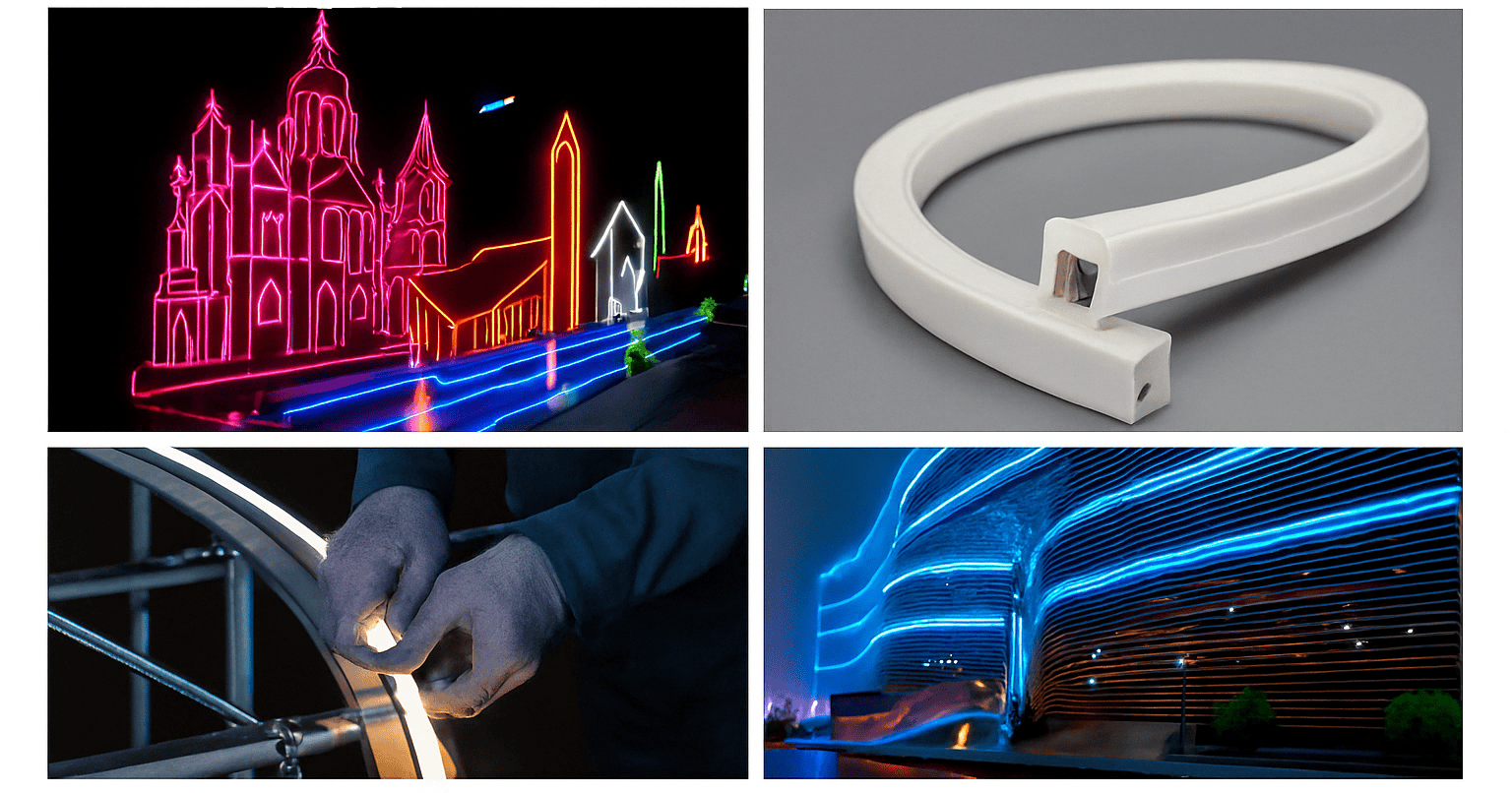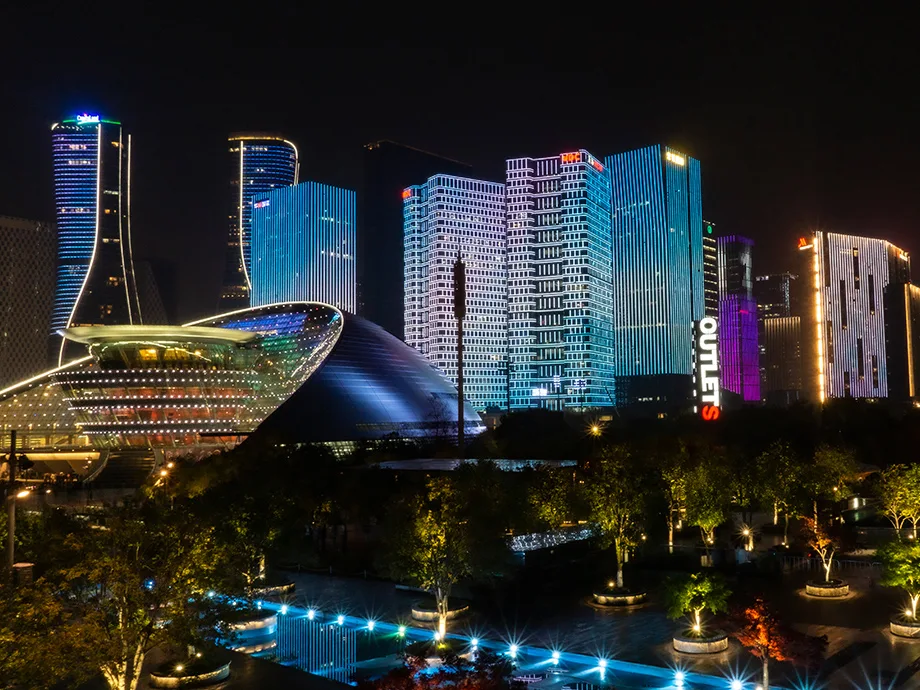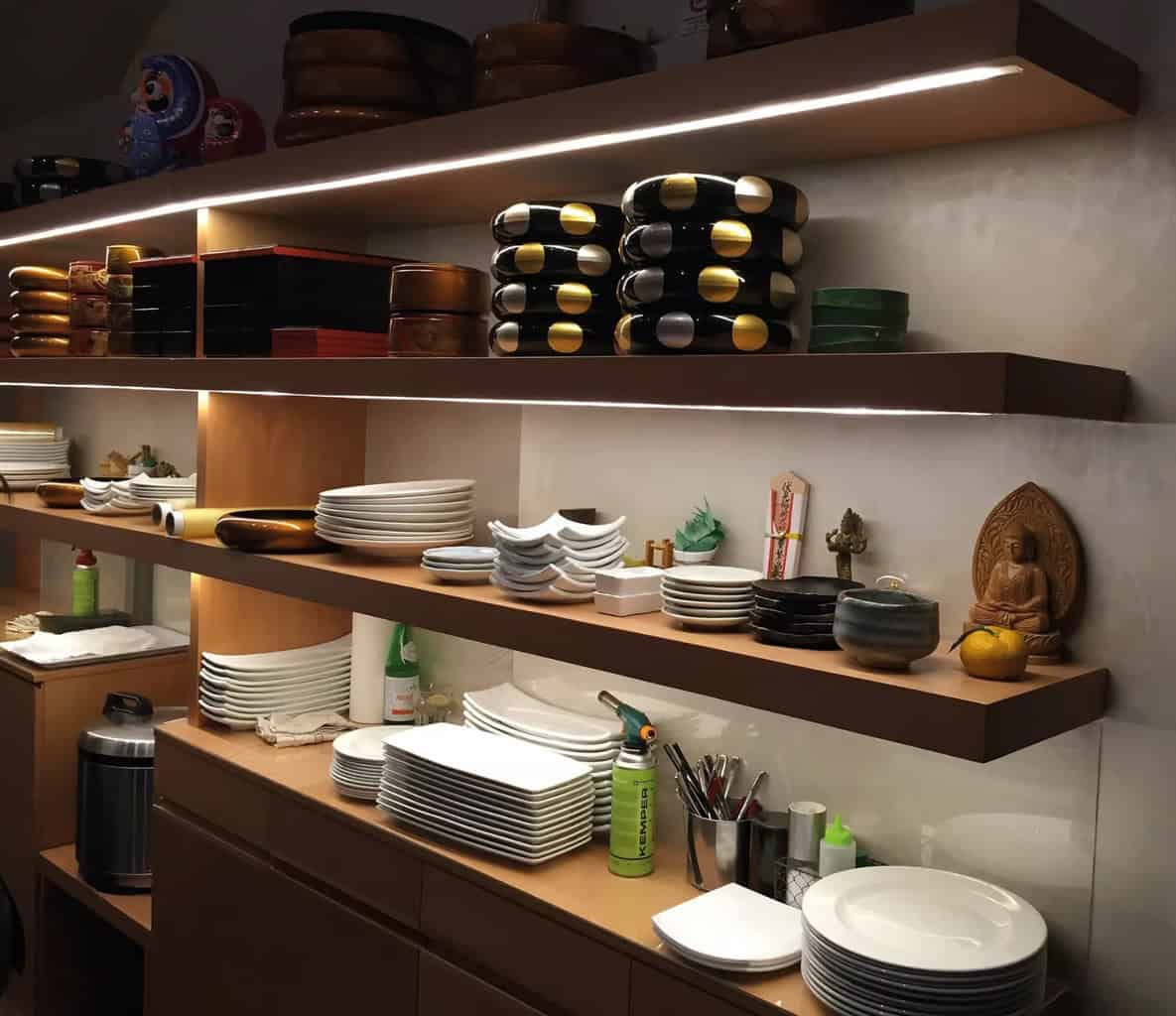LED strip lights have become a popular choice for decoration and lighting due to their energy efficiency, flexibility and malleability, and diverse application scenarios. However, many people may ask, “Can LED strip lights work properly without a plug?” In fact, with the right installation method and power solution, it is completely possible to install LED strip lights without plugs.
As a matter of fact, LED strip lights usually work under low voltage DC 5V, 12V, or 24V, so they can support a variety of power supply methods. In addition to traditional plug systems, you can also use battery-powered solar panels, mobile power, and more. There are also USB-powered LED strips on the market, so you can connect them to your PC or TV without any plugs. It is even possible to connect unplugged LED strips directly to a circuit or use an inverter, for example. Each of these methods offers a versatile and effective solution for powering LED strips in a variety of environments, but you should be aware of the proper procedures for implementing all of them, as failure to do so may result in problems such as voltage drops, short circuits, or permanent damage.
This article will take you through common mistakes made when powering LED strips and tips for connecting LED strips without plugs, and we are confident that you will find the solution that best suits your project or problem.
Do LED Strips Work Without Plugs?
The answer is yes!
LED strips work on the principle of being illuminated by a power supply, and the traditional way of connecting to a power supply is usually by using a plug. However, as long as the voltage and current requirements are met, LED strips can be connected to the power supply in other ways without relying on plugs. For example, the use of batteries, USB ports, or solar-powered devices can be realized without plug installation.
As we have already mentioned, LED strips usually operate at low voltage DC 5V, 12V, or 24V. If the mains supply is used directly for low-voltage LED strips, they will immediately burn out. So how do plug-in LED strips work? Low-voltage LED strips with plugs are equipped with a driver or transformer that converts the high voltage of the mains supply into a low voltage suitable for LED strips. You can replace the plug and driver with a battery pack, and it will work fine!
But now you may wonder: Why use a battery pack when the plug provides constant power from the mains?
This is because LED strips with plugs cannot be used in places where there are no sockets. For example, if you need to use it outdoors or in an environment where electricity is not available, in this case the LED strip will need a battery pack instead of the mains power supply.
10 Ways to Use LED Strips Without Plugs
LED lights that do not need to be plugged into a wall outlet require some form of power to operate. These alternative power supplies for LED strips provide flexibility in the use of the strips for a variety of needs and environments. Whichever alternative power supply you choose, make sure that you are able to supply the correct voltage and current to your LED strip lights to ensure their safe and efficient operation. Always follow the manufacturer’s guidelines and safety precautions when using electrical equipment.
To realize that LED strips don’t have to be plugged directly into a power source, we’ve listed ten ways to use LED strips without a plug.
1. Connecting LED Strips with USB

USB ports and USB connectors can be used for USB-powered LED strips, which makes it easy to power them through devices such as TVs, cars, USB wall adapters, mobile power, and computers. One thing to note, however, is that USB-powered LED strips are powered by DC 5V. If they are driven by 3V, they will still work but will be less bright; if they are driven by 12V, there is a high probability that they will be damaged.
USB LED strips with a low voltage of 5V are compatible with the rated voltage of your smartphone or computer, and you can easily find these strips in the lighting market or online. In addition to the USB LED strip, you will need a USB cable with the appropriate connector, which can be a micro USB, mini USB, or even a lightning connector, depending on the type of LED strip you have.
2. Use Portable Batteries
Standard disposable batteries (such as AA or AAA), lithium rechargeable batteries, or battery packs made specifically for LED lights can be used for these particular battery-powered LED strips. For these small/medium or battery-powered LED strips, portable battery power will eliminate the need for a plug.
Due to the operating environment of the strip batteries, these LED strips are typically used in indoor applications but can also be used in stowable outdoor applications where appropriate. Therefore, it is important to choose the right battery with the right voltage and capacity to power your LED strip lights. These portable batteries will help you light up your LED strip anywhere; whether you are traveling, having a party in the forest, or at the beach, charging your LED strip is easy.
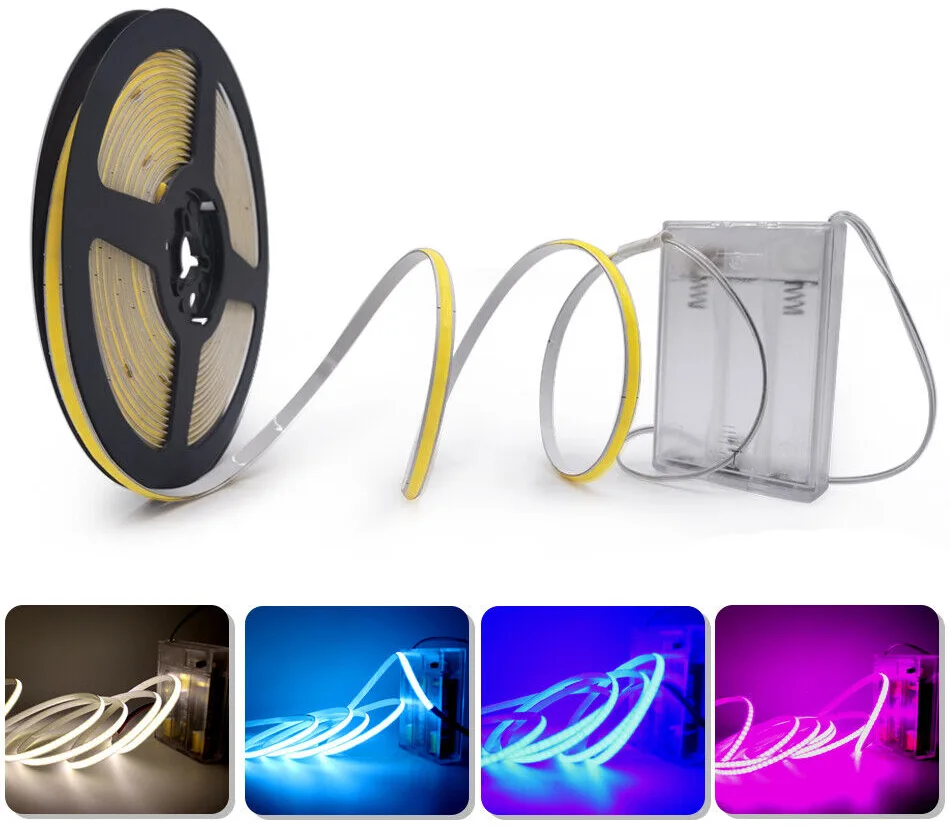
3. Use a DC Power Adapter
A DC power adapter is a common and stable power supply solution for LED strip lights, especially suitable for fixed installation scenarios, such as home decoration, store windows, and office areas.
A DC power adapter (DC power supply) is a device that converts alternating current (AC) to direct current (DC), which can provide stable current and voltage for LED light strips.LED light strips usually require low-voltage DC power, such as 5V, 12V, or 24V, depending on the design of the light strip. By choosing a suitable DC power adapter, you can ensure that the light strip works properly and extends its service life.
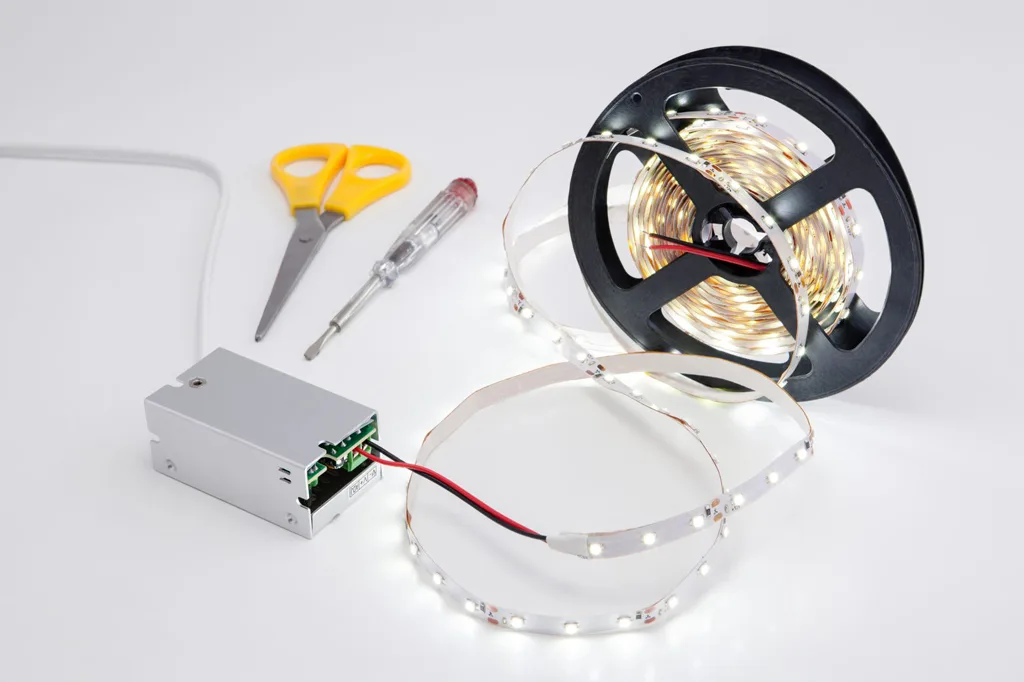
4. Use of Mobile Power
In most cases, a mobile power supply may be the right choice for you, as the low-voltage DC power from the mobile power supply can power the LED lights. You can use mobile power to power the LED strip in different environments. LED strips powered by mobile power are portable and can be used anywhere there is no electrical outlet. Therefore, these removable LED strips are perfect for camping, outdoor parties, and other scenarios where mobility is essential.

5. Using an Inverter
Another popular way to power LED strips is through an inverter, especially if you use multiple LED strip adapters or need to convert DC to AC. So, if your LED strip is 110V AC compatible, you can use an inverter to convert a 12V adapter or car battery to standard 110V AC. To do this, you must ensure that your car battery or adapter is providing a stable 12V DC power source to the inverter.
There is no doubt that using an inverter to convert DC power from a battery or solar panel to AC power is wasteful and can result in energy loss, while using DC power to power an LED strip directly eliminates this inefficiency. Avoid using an inverter if your LED strip runs on low voltage or uses lithium batteries.
6. Use Solar Panels
Solar energy is a free and renewable source of energy. So if you want an alternative to LED light strips that don’t use plugs, solar power is ideal for you. Some LED light strips will work with solar panels, which are designed to run the LED light strips by generating electricity from the sun. Obviously, they are often used in outdoor applications where there is direct sunlight.
Connect the LED light strip to the solar panel and place it in the sun to charge. This allows them to be charged and emit light without the need for any external power output. So when installing outdoor LED strips, consider using solar panels as a power source. Not only will it eliminate the hassle of plugs, but it will also save money on your electricity bill. However, you also need to consider two points: one is to choose a high-quality and IP-rated LED strip; the second is that the voltage of the solar panel and LED strip should be the same.
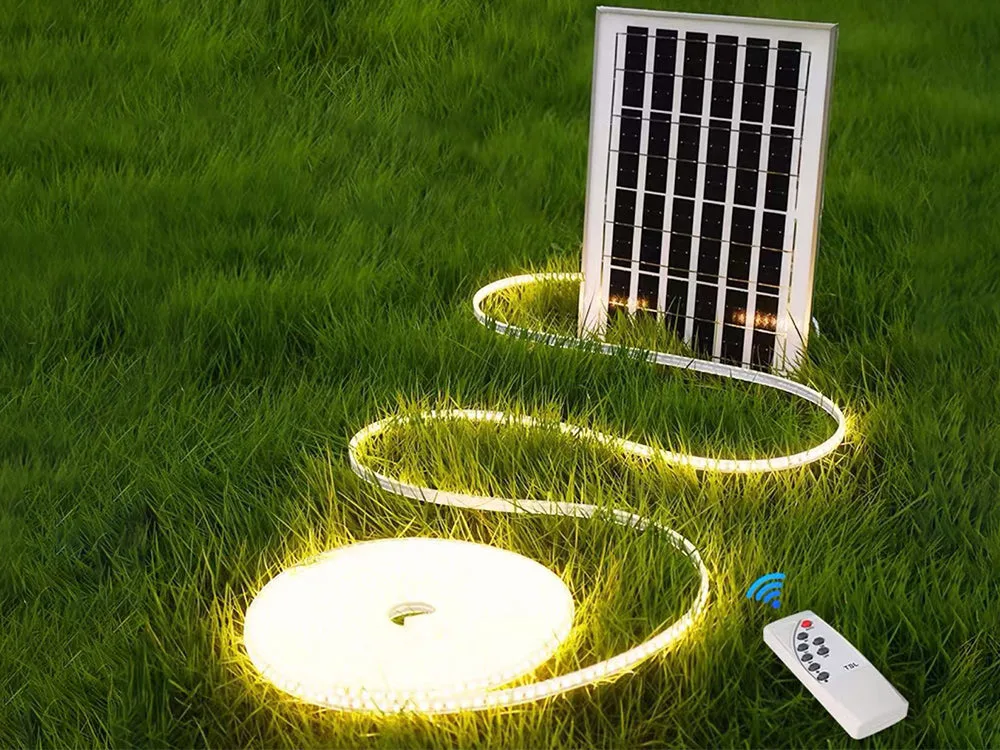
7. Use Extension Cords
Extension cords are the easiest way to power an LED strip without a plug. When there is no electrical outlet nearby, using an extension cord to power the LED strip is a practical solution. This solution is designed to extend the length to where the power supply is connected.
This is also used for combining two or more LED strips together to increase brightness or for other purposes, or for better alignment to maintain the lighting effect. For example, when the brightness of the LED strip is uneven, using an extension cord to connect the strip to the power supply, and the connection is located at the maximum length of the LED strip in the normal operating range (usually 5 meters), which means that there is no more voltage drop in the LED strip.
In any case, safety always comes first. To prevent overloading or other electrical hazards, make sure that the wire gauge of the extension cord is sufficient to withstand the current and power of the integrated LED strip and that all connections are secure.
8. Using a Hardwired-to-Fuse Connection
Hardwiring an LED strip to a fuse is an efficient way to power it without a plug. Hardwiring an LED strip to a fuse is a more permanent and specialized installation technique than plug-in adapters. Install the fuse connector where you plan to connect the LED strip and place the wiring in a wall, ceiling, or other concealed space to hide it. This way, it will hide all the wiring, providing you with not only safety and security but also a neat lighting setup.
However, this process requires a transformer or LED driver to convert the supply voltage to low voltage to meet the requirements of the LED strip. This is essential for the adequate operation and connection of LED strips, and you want to make sure that they will not be damaged by the high voltage. Therefore, if you are unsure if you can handle the electrical work yourself, consider hiring a professional electrician for the installation to avoid any potential risks.
9. Use Ribbon Cable
You can also connect LED strips directly to a ribbon cable to supply power without the need for a plug. However, you need to make sure that the voltage and current requirements of the LED strip match the voltage and current requirements that the ribbon cable can handle.
First, take some ribbon cable and cut it to the desired length. Then, connect one end of the ribbon cable to the LED strip and the other end to the power supply. Finally, use electrical tape to secure all the connections, make sure the connections are properly sealed, and then you can light up the LED strip while it works without a plug. Please note that you will need to solder or connect the wires between the strip and the ribbon cable correctly to ensure a strong connection.
10. Using Patch Cords and Breadboards
Combining jumper cables and breadboards is a way to use LED strips without a power plug.
First, the positive (+) and negative (-) terminals of the LED driver are already connected to the power rails of the breadboard separately, and all plugging occurs on the side of the DIP bracket, which is easy to understand and work with.
Next, connect the wires to the positive (+) and negative (-) terminals of the LED strip. Then, connect a jumper wire of the appropriate length and width to the same terminals on the LED strip. In this position, one end of the jumper wire will be attached to the LED strip, and the other end will remain free, plugging these remaining wires into the correct breadboard connections. Keep in mind that you will need a switch to make this setup.

Common Mistakes When Using LED Strips Without Plugs
There are some common mistakes we need to avoid when powering LED strips without plugs. If you don’t, some unavoidable accidents may happen, which may lead to fire and ruin your light strip. Therefore, before installing LED light strips, please pay attention to the following points:
Incorrect power supply voltage
A common mistake often made when powering an LED strip without a plug is using the wrong voltage. Incorrect driver voltage may result in unpredictable voltage output, which can damage the strip or cause uneven brightness. If the driver voltage is significantly higher than the voltage of the LED strip, the LEDs will be damaged and may even start a fire. If the supply voltage is significantly lower than the voltage of the LED strips, the latter may not work as intended. Always make sure that the rated voltage of the LED strip is matched to the adapter.
Reverse Polarity
Reversing the polarity is almost always the most common mistake when powering LED strip lights. Connecting the positive and negative terminals of an LED strip incorrectly can result in the lamp not working or being damaged. Remember that the positive terminal of the LED strip should be connected to the positive terminal of the power supply or driver, and the negative terminal should be connected to the negative terminal. Double-check the polarity before operation.
Overloading the Wires
Another common mistake is to overload the wires of an LED strip without connectors. The length and thickness of the wire are important to maintain voltage and current flow. When using long LED strips, thin wires or wires that are too small can cause a voltage drop or overload the wires. Overloaded cords can cause overheating and even fire. Make sure the wire can carry enough current to meet the power requirements of the strip.
Overloading the Power Supply
Connecting too many LED strips to a single power supply is another mistake you must avoid. This can lead to overloading of the power supply, which can lead to overheating and shorten the life of both the power supply and the LED strip. Therefore, before connecting LED strips to any power supply, make sure they can handle the load.
Bad Connection
Poor connections are one of the most common but often forgotten failures when using LED strips. Partially soldered joints or loose wires in the LED strip may cause failures or erratic performance. To avoid short circuits, make sure that all joints are tight and adequately insulated. In addition, insufficient insulation on soldered connections can lead to exposed wires or short circuits, both of which are dangerous. Heat shrink tubing or electrical tape can be used to shield and insulate connections.
Insufficient Heat Dissipation
LED strip lights generate heat, especially when operating in silicone tubing or at high efficiency or brightness. Without proper heat dissipation, overheating and premature damage can occur. Use aluminum profiles if necessary. They not only look great but also dissipate heat very well. In addition, the lack of 3M adhesive backing for LED strips is another reason for insufficient heat dissipation.The adhesive backing for LED strips does not only allow the strips to stick to the surface but also serves to dissipate heat. For more information on how to choose the right 3M adhesive backing, please read the article – How to judge and choose the quality of led light strip adhesive tape?
Inaccurate Measurement of Installation Area
Inaccurate measurement of the mounting area is an easily overlooked mistake when installing plugless LED strips. Often, it is easy to make a mistake when preparing to measure the length of the LED strip or cord. In addition to this, it is also very important that there is an outlet nearby. If this is overlooked, it can lead to a lot of trouble, such as soldering a long wire to supply power from another distant outlet. However, the wires may be visible and difficult to hide from the outside, which makes them look unattractive. Therefore, measure the installation area carefully when installing LED strips.
Failure to Check the Electrical System
Do not check the electrical system before connecting any LED strips. Check that the power supply can handle the extra load. In addition, some repairs may be required. If you do not check and connect the LED strip beforehand, there is a high risk of a short circuit or fire.
Using Poor-quality LED Strips
The quality of the LED strip is critical to the final lighting output. Using low-quality LED strips will not last longer. In addition, you may experience problems with the brightness of these lights. This is why I recommend that you look for branded LED strips. For this reason, SignliteLED is your ultimate solution. All of our LEDs are carefully categorized to provide a seamless lighting effect, and you can choose the LED strip you need from our wide variety of LED strips.
Tips for Connecting LED Strips Without Plugs
Connecting will be an important aspect when using LED strips without plugs. Knowing a few tips before installation will help avoid simple mistakes and unnecessary waste. To ensure proper installation and maintenance safety, you must follow some of these tips:
Use Solderless LED Strip Connectors
Soldering can be a hassle; to avoid this, use solderless connectors for LED strips that do not have plugs. Transparent solderless connectors are easy to use for LED strips and will not crush or damage the LEDs.Transparent solderless connectors for LED strips will also not affect the seamless lighting effect. LED strips are firmly connected and not easy to pull off.
Choosing a DC Power Source
DC power is always a good choice for connecting plugless LED strips compared to other power sources such as solar panels. It has less energy loss and is more environmentally friendly than, for example, mobile power sources that require batteries. It is recommended to use Meanwell power supplies, which are well known in the industry for their high quality.
Use Wire Nuts to Secure Wires
If you are using external wires on your LED strip, it is best to secure them with wire nuts. This will keep your lights looking neat and prevent you from tripping over the wires and other accidents.
Using Heat Shrink Tubing
When using connectors or soldering, make sure the joints are tight so they don’t loosen over time. To insulate and protect splices, use heat shrink tubing. Heat shrink tubing is great for hiding exposed wires or connectors, and it can help protect lighting from corrosion-related damage. Heat shrink tubing is available in many different sizes, so choose a size that matches your light strip when purchasing.
Distribute Power Evenly
To avoid voltage drops and ensure consistent brightness, longer LED strip installations may need to consider spreading power over the entire length of the strip. If more than one power source is required, power injection points can be used.
Pre-Installation Testing
Always test connections and functionality before permanently installing LED strips so you can more easily troubleshoot any issues.
Conclusion
In conclusion, LED strips are flexible fixtures with a wide range of uses. Using LED strips without traditional plugs opens up a myriad of creative possibilities for lighting your space, whether you choose a battery pack, a USB connection, a solar panel, or another alternative power source. However, it’s important to prioritize safety precautions, select high-quality components, and follow proper installation techniques to ensure the longevity and efficiency of your lighting fixtures.
If you would like to use high-quality LED strips for your project, check out our list of LED strips. We also have LED strip connectors, LED controllers, and LED drivers to help you with your DIY projects.
